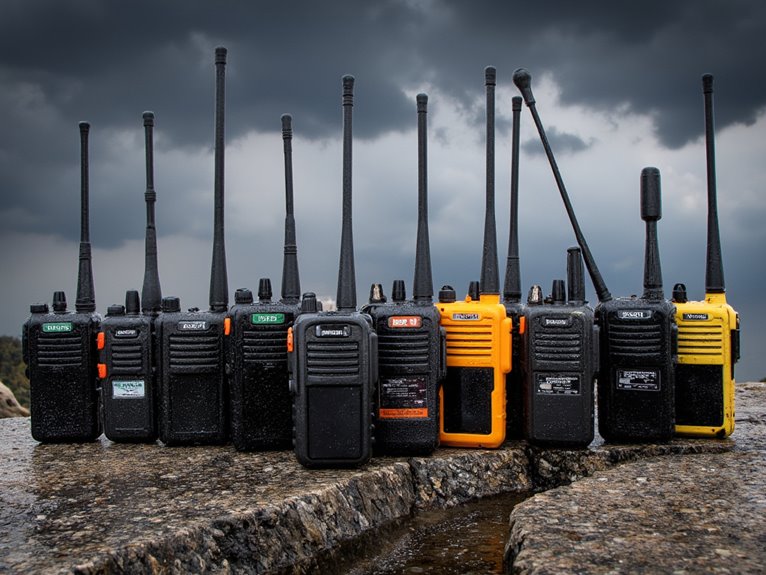How Long Can a Bushcraft Shelter Last?
A well-constructed bushcraft shelter can last anywhere from a few days to several weeks or even months, depending on the quality of its construction, the materials used, and the environmental conditions it is subjected to. The durability of a shelter is influenced by factors such as weather resistance, structural integrity, and material quality. A lean-to shelter can last for several weeks or months, while a debris shelter's lifespan ranges from a few days to several weeks. By understanding the impact of environmental conditions and using robust building techniques, you can substantially extend the lifespan of your bushcraft shelter – and exploring these factors further can reveal more insights into achieving a reliable and long-lasting shelter.
We are supported by our audience. When you purchase through links on our site, we may earn an affiliate commission, at no extra cost for you. Learn more. Last update on 1st January 2026 / Images from Amazon Product Advertising API.
Materials Used in Bushcraft Shelters
Selecting the right materials is essential in bushcraft shelter construction, as they directly impact the structure's durability, weather resistance, and overall functionality.
Natural materials such as branches, leaves, and pine needles are often preferred due to their availability and camouflage properties.
Tarpaulins and space blankets can also be used to provide additional protection from the elements.
It is imperative to choose materials that are suitable for the environment and can withstand local weather conditions.
For example, in areas with high winds, using sturdy branches and securing them properly is essential.
Building Techniques for Durability
By employing robust building techniques, bushcraft enthusiasts can guarantee their shelters withstand the rigors of the wilderness and provide a safe haven from the elements, thereby safeguarding a secure refuge.
A well-constructed shelter is essential for survival in harsh environments.
To achieve durability, it's vital to examine factors such as structural integrity, wind direction, and drainage.
Techniques like using sturdy branches, anchoring the shelter securely, and incorporating a waterproof layer can substantially improve the shelter's lifespan.
Additionally, paying attention to details like securing the roof and ensuring a snug fit between components can prevent damage and leaks.
Weather Conditions Affecting Shelters
When building a bushcraft shelter, it is vital to take into account the impact of weather conditions on its structure and integrity.
Wind and rain can cause significant damage, while prolonged sun exposure can lead to degradation of materials and compromised shelter performance.
Understanding these factors is vital to designing and constructing a shelter that can withstand the elements and provide reliable protection in the wilderness.
Wind and Rain Damage
Harsh weather conditions, particularly strong winds and heavy rainfall, can compromise even the sturdiest of bushcraft shelters, making it essential to consider these factors during the construction process.
Wind can exert significant pressure on the structure, causing it to shift or even collapse, while rain can seep into the shelter, rendering it uninhabitable.
A well-designed shelter should be able to withstand wind speeds of at least 30 miles per hour and rainfall of up to 2 inches per hour.
To mitigate wind damage, it's crucial to anchor the shelter securely to the ground and use sturdy materials that can resist wind pressure.
For rain protection, a waterproof layer, such as a tarp or plastic sheet, should be used to ensure the shelter remains dry and habitable.
Sun Exposure Effects
Prolonged sun exposure can lead to shelter degradation, as ultraviolet rays can cause materials to deteriorate, compromising the structure's integrity.
The effects of sun exposure can be particularly damaging to natural materials like leaves, grasses, and animal hides, which can become brittle and fragile. Synthetic materials, such as tarps and nylon, can also degrade, losing their water resistance and becoming prone to tears.
In extreme cases, prolonged sun exposure can cause materials to disintegrate, leading to a complete loss of shelter functionality.
To mitigate these effects, providing shade for your shelter, using natural canopies or artificial shading devices, is vital. Regular maintenance and material inspections are also vital to prolong the life of your bushcraft shelter.
Typical Lifespan of Debris Shelters
In terms of debris shelters, understanding their typical lifespan is vital for wilderness survival.
The durability of a debris shelter depends on various factors, including the quality of construction, environmental conditions, and the materials used.
Shelter Durability Factors
The durability of a debris shelter is largely determined by the quality of its construction, the type of materials used, and the environmental conditions it is exposed to.
A well-built shelter using sturdy branches, leaves, and other natural materials can withstand harsh weather conditions and last longer.
Conversely, a poorly constructed shelter using weak materials may not survive a single rainstorm.
The type of materials used also plays a vital role in determining the shelter's durability.
For instance, using wet or rotten wood can greatly reduce the shelter's lifespan.
Environmental factors such as wind direction, rainfall, and temperature also impact the shelter's durability.
Understanding these factors is essential to building a long-lasting debris shelter.
Average Lifespan Expectations
On average, a well-built debris shelter can last anywhere from a few days to several weeks, depending on the quality of construction and the environmental conditions it is exposed to.
Factors such as weather, terrain, and maintenance all impact the shelter's lifespan.
In ideal conditions, with minimal wind and rain, a debris shelter can last up to several weeks.
However, in harsher environments, such as areas with high winds or heavy rainfall, the shelter's lifespan may be substantially shorter.
Proper construction, regular maintenance, and adaptation to changing environmental conditions can all contribute to a longer-lasting shelter.
Understanding the typical lifespan of a debris shelter is essential for bushcraft enthusiasts and outdoor enthusiasts alike, enabling them to plan and prepare accordingly.
Lean-To Shelter Average Lifespan
A well-constructed lean-to shelter can last for several weeks, even months, depending on the quality of its construction, the materials used, and the environmental conditions it is exposed to.
The lifespan of a lean-to shelter is largely determined by the durability of its ridgepole, which bears the weight of the structure. A sturdy ridgepole made from a hardwood tree like oak or ash can withstand harsh weather conditions and support the shelter's framework for an extended period.
Additionally, the type of roofing material used, such as leaves, grasses, or pine needles, can affect the shelter's longevity.
Properly constructed and maintained, a lean-to shelter can provide reliable protection from the elements for an extended period.
Snow Shelter Durability Factors
When building a snow shelter, two critical factors contribute to its durability: snow load capacity and wind resistance factors.
The ability of the shelter to withstand the weight of snowfall and resist wind forces is vital to its longevity.
Understanding these factors is essential to constructing a reliable and safe snow shelter in harsh winter environments.
Snow Load Capacity
Any snow shelter's ability to withstand the weight of snowfall is largely dependent on its structural integrity, which is influenced by factors such as the shape and angle of the roof, the type of building materials used, and the overall construction quality.
A shelter with a steeply pitched roof, for instance, is more likely to shed snow effectively, reducing the weight on the structure.
The type of materials used also plays a vital role, with sturdier materials like sturdy branches and thick tarps providing better support.
In addition, a well-constructed shelter with a solid foundation can distribute the weight of snow more evenly, increasing its snow load capacity and overall durability.
Wind Resistance Factors
In addition to snow load capacity, wind resistance is a critical factor in determining the durability of a snow shelter, as it can exert significant lateral pressure on the structure, compromising its stability.
The velocity and direction of wind, as well as the shelter's shape and orientation, all impact wind resistance.
A well-designed snow shelter should be angled to deflect wind and snow, reducing pressure on the structure.
Additionally, a sturdy door and entrance can help to distribute wind force, while a sturdy anchor system can secure the shelter to the ground.
Furthermore, by considering wind resistance factors, bushcraft enthusiasts can build a more resilient snow shelter that can withstand harsh winter conditions.
Factors Affecting Shelter Longevity
Several factors, including environmental conditions, material quality, and construction techniques, substantially impact the longevity of a bushcraft shelter.
Environmental conditions such as weather, temperature, and humidity can cause wear and tear on the shelter.
Material quality is also vital, as durable materials can withstand harsh conditions, while inferior materials may deteriorate quickly.
Construction techniques, including the design, framework, and anchoring system, also play a significant role in determining the shelter's lifespan.
Additionally, maintenance and upkeep are essential to extend the shelter's lifespan.
Regular inspections and repairs can help prevent damage and confirm the shelter remains safe and habitable.
Natural Shelter Lifespan Expectations
Natural shelters, such as those constructed from fallen trees or rock overhangs, typically have a shorter lifespan expectancy compared to purpose-built shelters, as they are more susceptible to environmental degradation and erosion.
The lifespan of a natural shelter can range from a few weeks to several months, depending on factors such as weather conditions, soil quality, and vegetation growth.
In areas with high winds, heavy rainfall, or extreme temperatures, natural shelters may only last for a short period.
In more favorable conditions, they can provide temporary protection for an extended period.
Understanding the limitations of natural shelters is essential in bushcraft, as it allows individuals to plan and prepare accordingly, ensuring a safe and sustainable shelter solution.
Maintaining Your Bushcraft Shelter
Proper maintenance is vital to extending the lifespan of your bushcraft shelter, regardless of whether it's a natural or purpose-built structure.
Regular upkeep ensures your shelter remains safe, functional, and protected from the elements.
To maintain your bushcraft shelter, consider the following:
Inspect and repair damaged or worn-out components, such as torn fabric or loose ropes.
Keep the shelter clean to prevent debris buildup and pest infestation.
Apply waterproofing treatments to protect the shelter from rain and moisture.
Trim surrounding vegetation to maintain airflow and reduce fire hazards.
Extending Shelter Lifespan Tips
By incorporating a few simple yet effective strategies into your maintenance routine, you can substantially extend the lifespan of your bushcraft shelter.
Regularly inspect and repair or replace damaged or worn-out components, such as torn fabric or broken poles, to prevent further damage.
Apply waterproofing treatments to the shelter's fabric and seams to maintain its water resistance.
Additionally, verify the shelter is properly secured to the ground and anchored to nearby trees or rocks to prevent wind damage.
Finally, store the shelter in a dry, well-ventilated area when not in use to prevent mold and mildew growth.


